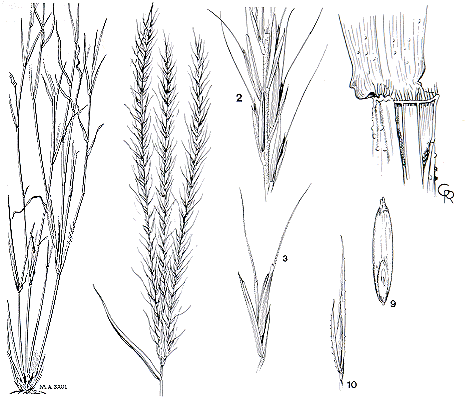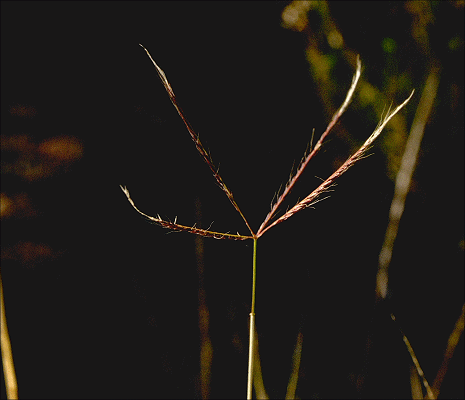Enteropogon ramosus B.K. Simon. Austrobaileya
2: 1 (1984).
Classification. (GPWG 2001) : Subfamily
Chloridoideae. Cynodonteae.
Type of Basionym or
Protologue Information: Australia:
Queensland:
Mitchell Distr.: 1 km S of Tambo towards Augathella, May 1975, Simon &
Clarkson 2810 (HT: BRI-228353; IT: CANB, K, L, NSW).
Recent synonyms:
Chloris acicularis var. queenslandiae, E. acicularis Form
A.
Key references
(books and floras): [2002] D.Sharp & B.K.Simon, AusGrass, Grasses of
Australia,
[2006] J.Jessop, G.R.M.Dashorst, F.M.James, Grasses of South Australia
(358), [2008] S.W.L.Jacobs, R.D.B.Walley & D.J.B.Wheeler, Grasses of New
South Wales (243).
Illustrations:
[2006] J.Jessop, G.R.M.Dashorst, F.M.James, Grasses of South Australia (359, fig. 289), [2008] S.W.L.Jacobs,
R.D.B.Whalley & D.J.B.Wheeler, Grasses of New South Wales, 4th edn
(243).
Habit.
Perennial. Culms stature robust to moderate, 30–100 cm tall, 4–6 -noded.
Mid-culm internodes glabrous. Lateral branches branched. Leaves cauline.
Leaf-sheaths smooth or papillose, glabrous on surface. Ligule a fringed
membrane, a ciliolate membrane, 0.3 mm long. Leaf-blades tortuous, flat, 3–20
cm long, 1.5–5 mm wide.
Inflorescence.
Inflorescence digitate, with spicate branches.
Spikelets.
Spikelets sessile. Fertile spikelets 1 or more flowered, with 1 fertile floret,
comprising 1 fertile floret(s), with diminished florets at the apex,
lanceolate, laterally compressed, 6–9 mm long.
Glumes. Glumes
similar, thinner than fertile lemma. Lower glume linear, membranous, without
keels, 1 -nerved. Lower glume apex muticous or mucronate. Upper glume linear,
3.5–7.3 mm long, membranous, without keels, 1 -nerved. Upper glume apex
mucronate or awned.
Florets.
Fertile lemma 5.5–9 mm long, keeled, 3 -nerved. Lemma apex entire, awned, 1
-awned. Median (principal) awn 9–14 mm long overall. Palea 2 -nerved. Anthers
3. Grain 2–5 mm long.
Continental
Distribution: Australasia.
Australian
Distribution: Western Australia, Northern Territory, South Australia,
Queensland, New South Wales.
Western
Australia: Gardner.
Canning, Giles, Fortescue, Ashburton, Carnarvon. Northern
Territory: Darwin & Gulf, Central Australia North, Central Australia South. South Australia:
North-western, Lake Eyre, Gairdner-Torrens Basin, Flinders Ranges, Eastern,
Eyre Peninsula, Northern Lofty, Murray, Southern Lofty. Queensland:
Cook, Burke, North Kennedy, South Kennedy, Port Curtis, Leichhardt, Burnett,
Darling Downs, Gregory North, Gregory South,
Mitchell, Warrego, Maranoa. New South Wales: North-Western Slopes,
Central-Western Slopes, South-Western Slopes, North-Western Plains,
South-Western Plains, North Far Western Plains.
Notes.
Dried specimens of E. ramosus are most reliably distinguished from those
of E. acicularis by the combination of completely glabrous foliage
(except for occasional hairs behind the ligule) and the absence of a
contra-ligule. In addition, E. ramosus tends to be taller with fewer
spikes and the branching at several nodes is distinctive in more mature
specimens. The 2 species may be more readily distinguished in the field, as the
spikes of E. ramosus are reported to spread in a single plane while
those of E. acicularis are arranged in several planes. The leaves of E.
ramosus are borne along the whole culm length, but are mostly basal in E.
acicularis, though this may be partly related to the height. Abruptly
twisting mature leaves have been seen on specimens of E. acicularis but
this condition is more common in E. ramosus.
The
most common species of Enteropogon in Australia, with a distribution in
all States except Vic. and Tas., chiefly inland in arid and lower-rainfall
regions, but nearer the coast in south-central Qld, and in W.A. from the
Kimberleys to the SE corner. In N.S.W., mostly confined to the NW corner, with E.
acicularis and intermediate forms predominant in the remainder of the
state, and in Vic. Usually on light-textured soils such as sandy loams, but
also known from heavy-textured red earths and skeletal soils; often in
seasonally wet areas such as creek beds, with Eucalyptus camaldulensis
or Melaleuca, or in woodlands with box (Eucalyptus populnea),
wilga (Geijera parviflora), gidgee (Acacia cambagei) or mulga (Acacia
aneura), or in mallee or shrublands with Atriplex, Maireana, Acacia
and Triodia; often common but never dominant in the understorey.





